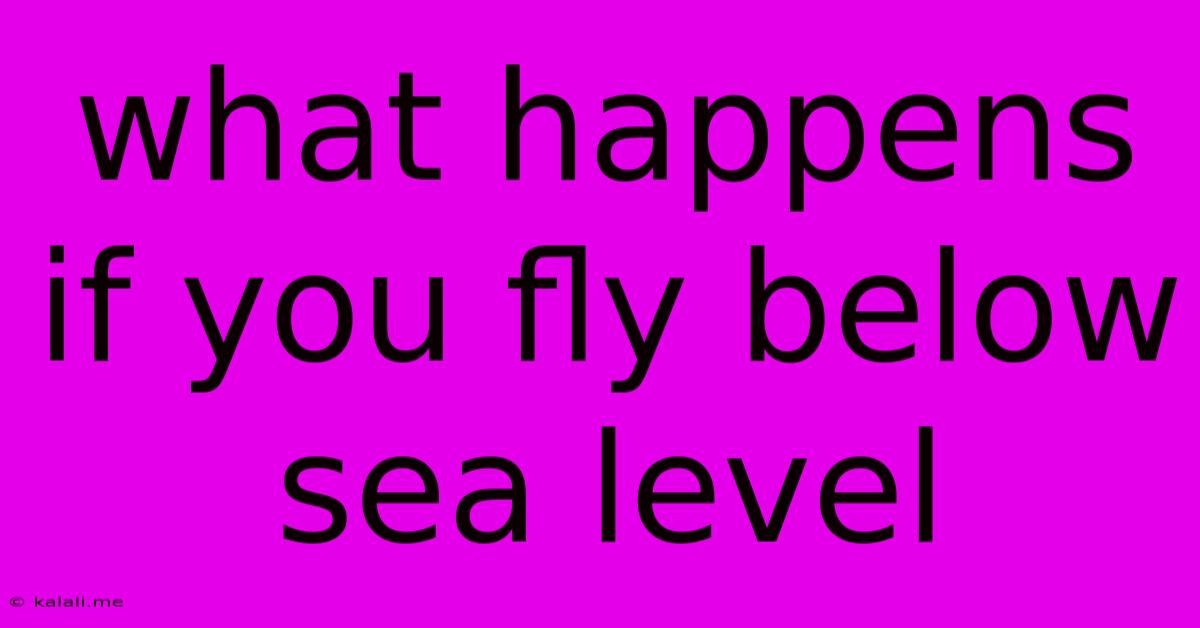What Happens If You Fly Below Sea Level
Kalali
Jun 06, 2025 · 3 min read

Table of Contents
What Happens If You Fly Below Sea Level? The Physics of Impossible Flight
This article explores the fascinating, and ultimately impossible, concept of flying below sea level. We'll delve into the physics behind flight and why defying gravity underwater remains firmly in the realm of science fiction. This will cover the density of air and water, the principles of lift, and the challenges of propulsion in these vastly different mediums.
Imagine a scenario: a plane attempting to "fly" beneath the ocean's surface. What would happen? The short answer is: it wouldn't work. The fundamental principles of flight that govern airplanes, helicopters, and even birds, simply cannot operate underwater.
The Crucial Role of Air Density
Aircraft rely on the principles of aerodynamics. Wings are designed to create lift by manipulating airflow. Faster-moving air over the curved upper surface of the wing creates lower pressure, compared to the slower-moving air beneath. This pressure difference generates an upward force, counteracting gravity. This process is entirely dependent on air density.
Water, however, is significantly denser than air. Approximately 800 times denser, to be precise. This density drastically alters the equation. The forces required to move a plane through water at the speeds needed to generate lift are astronomical, far exceeding the capabilities of any current propulsion system.
Propulsion Challenges: From Wings to Propellers
Even if we could somehow generate the necessary lift in the extremely dense medium of water, the propulsion systems required pose an immense challenge. Airplanes rely on propellers or jet engines that efficiently move air to generate thrust. These systems are not designed for the high resistance of water. The energy needed to move a substantial aircraft through water would be enormous, resulting in inefficiency and likely structural failure.
Submarines, designed specifically for underwater travel, utilize entirely different principles. They achieve movement through powerful electric motors, using a streamlined shape to minimize drag in water, rather than relying on manipulating air pressure for lift.
The Science of Buoyancy: A Different Kind of "Flight"
While flying below sea level is impossible, underwater movement is achieved through other methods. Submarines utilize the principle of buoyancy – controlling their overall density to achieve neutral buoyancy, allowing them to float at a desired depth. This is drastically different from the principle of lift used by aircraft. They don't "fly" in the traditional sense, but rather navigate within the three-dimensional space of the water column by adjusting their internal buoyancy.
Why the Idea Remains Appealing
Despite the impossibility, the idea of flying below sea level continues to capture our imaginations. It is a testament to our innate desire to overcome limitations and explore new possibilities. Science fiction often explores such concepts, using advanced technology to imagine scenarios that push the boundaries of what we know is possible. But while we might see "underwater flight" in movies, the basic laws of physics remain unyielding.
In conclusion, flying below sea level is physically impossible with current technology and understanding of physics. The differences in density between air and water, the challenges of propulsion, and the fundamentally different principles governing flight versus underwater navigation make it a concept that will remain in the realm of fantasy, rather than reality.
Latest Posts
Latest Posts
-
Actors In The Movie John Carter
Jun 06, 2025
-
How To Get Smoke Smell Out Of Apartment
Jun 06, 2025
-
Do Outside Users In Sharepoint Need Microsoft License
Jun 06, 2025
-
Kwik Plug Connected To Output Jack
Jun 06, 2025
-
Easier Way To Filer By Ssn In Sql
Jun 06, 2025
Related Post
Thank you for visiting our website which covers about What Happens If You Fly Below Sea Level . We hope the information provided has been useful to you. Feel free to contact us if you have any questions or need further assistance. See you next time and don't miss to bookmark.